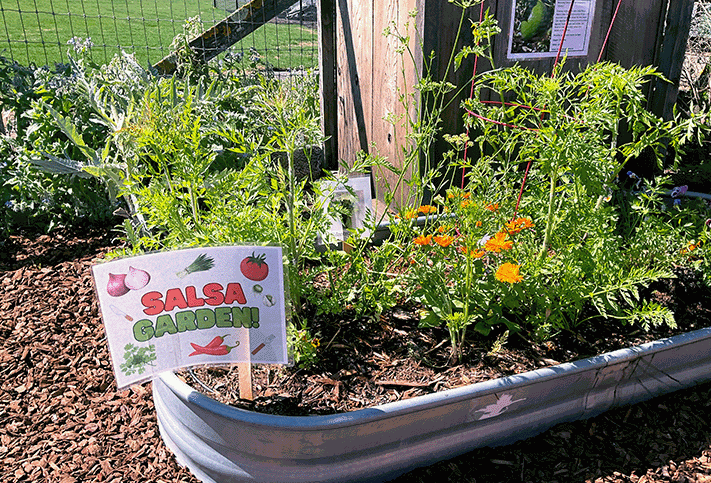Posted: September 24, 2024
Learn about green thinking and the benefits for children and caregivers. Find ideas for greening or naturalizing outdoor environments for children.

Salsa garden photo taken at North Bay Children’s Center, Garden of Eatin’®.
Green thinking is a way to support educators in designing safe, healthy, and engaging learning environments for young children. Green thinking includes practices like:
- greening outdoor environments
- fostering green muscle memory
Greening or naturalizing environments are when ample natural resources are added to outdoor spaces and combined with hands-on experiences to enhance children’s health and well-being, education, and collective joy within their early learning community.
Green spaces offer pleasing environments where children and caregivers can gather, cultivate meaningful relationships, and share knowledge. Exposure to natural green spaces supports diverse health benefits, such as decreased myopia (nearsightedness), improved self-regulation and cognitive performance, and reduced symptoms of attention-deficit hyperactive disorder (Bole et al., 2024) (Faber Taylor & Kuo, 2008).
Not all children have access to nurturing green spaces. Greening outdoor environments is one way to ensure all children can consistently and frequently access safe outdoor spaces and nature’s numerous benefits, contributing to environmental justice. Exposure to nature stimulates children’s sense of wonder and curiosity about the natural world early in life. It inspires children to fall in love with nature, develop empathy, and learn about and care for living things.
Outdoor environments are strengthened by adding natural resources, contributing to resilient practices that protect children and staff from a changing climate and increased weather events. For instance, programs can better manage excessive heat and improve air quality by adding trees, shrubs, gardens, planters, and vegetation to outdoor spaces. Green spaces help to provide shade, remove pollutants and particulates, and sequester carbon.
Greening outdoor environments can include small and significant additions, such as adding:
- native trees, shrubs, plants, grasses, flowers, and natural ground covers
- edible planters, raised garden beds, and full gardens (fruits, vegetables, and herbs)
- shade areas and portable structures (canopies, shade sails, and covered decks)
- natural elements (logs, log segments, river rock, and other natural loose parts)
- mud and sand play kitchens and spaces
- stormwater capture elements (rain barrels, dry creek/stream beds, permeable ground cover)
Young children build green muscle memory when they use repetitive, daily practices like watering plants and being responsible for filling, storing, and keeping track of reusable water bottles. Green muscle memory (Coon, Dennis, & Walker, n. d.) refers to learning about and repeating actions that support environmental and ecological behaviors and habits. These natural actions become part of children’s automatic habits and behaviors, or green muscle memory.
When children learn about practices such as recycling and composting—routines that repeat daily and across settings (home, school, community spaces, etc.)—green practices become second nature. Additionally, greening outdoor environments presents opportunities for children to naturally interact with green spaces and practice actions like caring for worms in the compost garden, which assists in fostering green muscle memory. Children learn that their green muscle memory actions make a difference in caring for their special places in nature, building a sense of joy, ecological stewardship, and a deep appreciation for nature, both now and in the future.
What green thinking practices will you try? Find more green thinking inspiration in the Making Spaces: Connecting Children to Nature through Thoughtful Facility Design from the National Children’s Facilities Network (Includes outdoor videos!).
References:
Bole, A., Bernstein. A., White, M. J., & Council on Environmental Health and Climate Change, Section on Minority Health, Equity, and Inclusion. (2024). The Built Environment and Pediatric Health. Pediatrics 153(1): e2023064772.
Coon, B., Nolasco, D., & Walker, E. (n.d.). Climate Education Vs. the Climate Crisis. EARTHDAY.org.
Faber Taylor, A., & Kuo, F. E. (2009). Children with attention deficits concentrate better after walk in the park. Journal of Attention Disorders, 12(5), 402-409.

